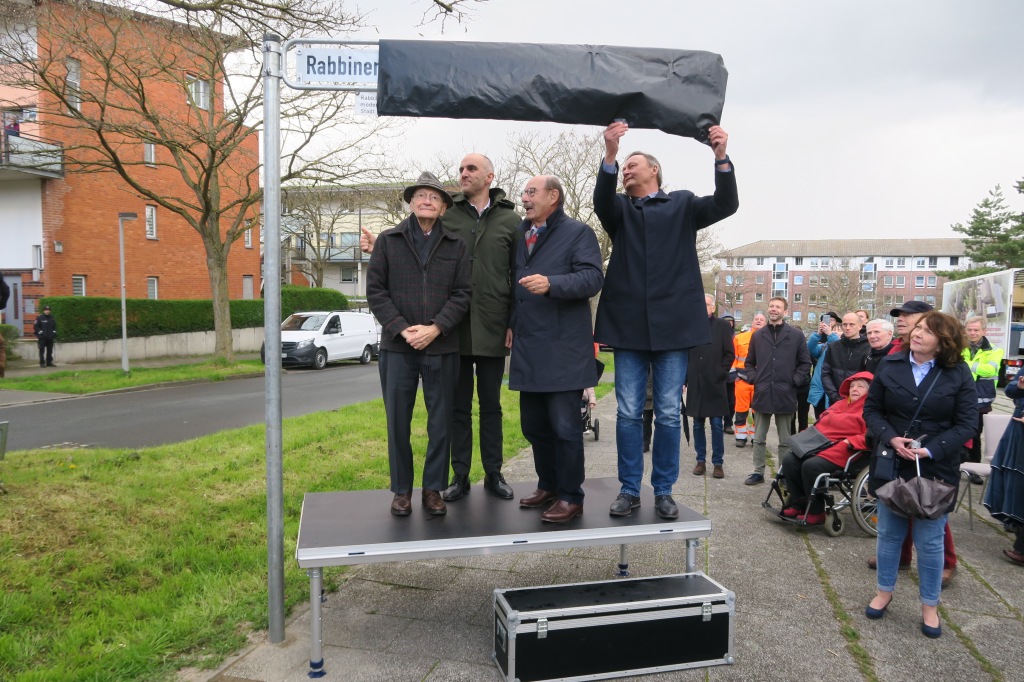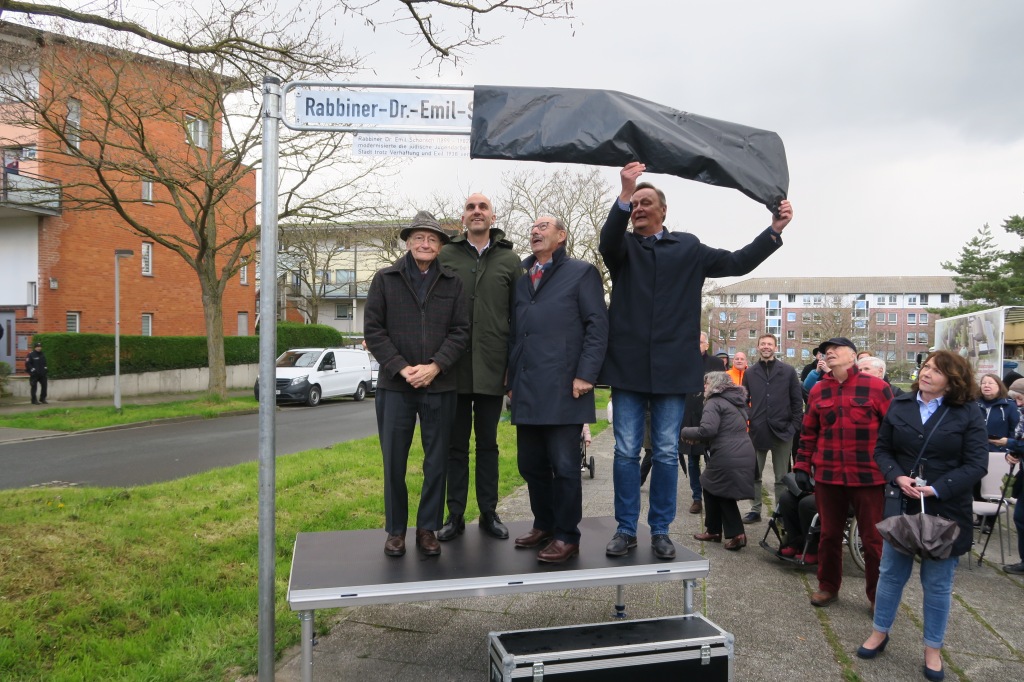Last week I met my parents and sisters, who flew in from the U. S., in Hannover. The city had decided to name a square after my grandfather, Emil Schorsch, who had been rabbi in the main synagogue there from 1927 until 1938.
On Tuesday morning we met our guides, two employees of the ZeitZentrum Civil Courage, an interactive educational site developed by the municipality that focuses on the impact that Nazism had on society in the city. They walked us to our first event, lunch with the mayor. The city added the U. S. flag to the row of flags (Hannover, Germany, the EU) in front of the palatial city hall (shown in the photo below), a welcoming honor offered to every significant visiting delegation.

The entry level of this imposing 1913 edifice features the kind of miniature model of the city that Germans seem to love. This one, a model-map of Hannover in earlier years, shows the so-called New Synagogue (opened in 1870), where Emil served as the youth rabbi, which was burned down on Kristallnacht, November 9th, 1938 by Nazi thugs and their supporters.
As we discovered later in the week, the photographer who snapped this remarkable and disconcerting image in the early morning of that day of infamy, probably from the church tower opposite, was a zealous Nazi himself. During the war years he wrote a tract blaming the Jews for having caused all the problems.
Things have changed in Hannover since then. Our host for lunch, Lord Mayor (Oberbürgermeister) Belit Onay, is a congenial, diplomatic, and impressive 42-year-old Green Party member, an attorney trained in energy policy, born and raised in Germany by Turkish parents who came originally as “guest workers.” He is the first mayor of Turkish background to lead a major German city, he informed us. During the election, he related, his background seemed to act as a positive factor for many voters, though after he won a hate campaign instigated by right-wing forces arose on social media.
Later in the afternoon our guides delivered us to the square which was to be renamed. The city has undertaken an intentional program of renaming streets and other locations that bear the names of individuals whose legacies are, from the perspective of our times, complicated and controversial. The square, now situated in the midst of an intentionally-built neighborhood of short and attractive residential buildings that were constructed according to the then-most advanced environmentally-friendly standards, used to be a hilly natural space where Emil took his youth group teenagers for hikes. The new neighborhood houses a very mixed population, typical of so many German cities these days. At the peak of his activities leading the synagogue’s youth, some 1,000 youngsters participated each shabbat, leading their own prayer services, discussing Torah, Judaism, and Jewishness, and engaging in character-building activities like hiking.

Speeches by various officials, a leader of the city’s Jewish community, and my father, Emil’s son, Rabbi Dr. Ismar Schorsch, noted Emil’s major impact on the city’s Jewish youth. He intentionally welcomed the participation not only of youngsters from his own synagogue, which represented the local German Jews, but also those from the population of eastern European immigrants, the Ostjuden, who had flocked to Germany in the wake of pogroms, revolutions, and economic stagnation and who usually received a less-than-enthusiastic welcome from the local Jews. Though only in his 20s and then 30s himself, Emil, raised in a Jewish orphanage in Esslingen, in southern Germany, a soldier on the eastern front in WWI, trained for the rabbinate at Breslau, the first modern rabbinical seminary in Germany, educated and inspired his young charges with his precocious and wide knowledge of Judaism and empathetic sensibilities. As one speaker remarked, Emil also possessed a PhD in pedagogy from the University of Tübingen, marking him as a typical German rabbi of the time, a post-Enlightenment product of rigorous religious and also “scientific” education. (Nearly none of the rabbis in Germany today can claim both rabbinic ordination and a doctorate. One of the sorriest examples of a contemporary rabbi who has a PhD — two, actually — is currently embroiled in a wild scandal due to numerous allegations of abuse of power, fabrication of his background, and academic plagiarism. But that is another story…) Emil’s pedagogic approach drew from the progressive Protestant pedagogical theories that also influenced his father-in-law, Theodor Rothschild, the director of the orphanage in Esslingen, that sought to cultivate the whole person.

Through a relative who operated a major plywood factory near Hannover, with whom Emil’s brother worked as an engineer, Fanny managed to obtain visas for England from the English chief rabbi, Joseph Hertz, who had the authority to issue visas for German Jews in “useless” occupations like rabbi. Not allowed to remain in England according to the terms such visas, Fanny and Emil and their two young children moved on after a year to the U. S. I remember Emil well. As a child I experienced him and Fanny as thoroughly German, that is, foreign, serious, intense. In the United States, Emil officiated at Congregation Mercy and Truth in Pottstown, PA, then at Beth Israel Synagogue in Vineland, NJ. He continued to wear, on special occasions such as the high holidays, the formal German-style rabbinical hat shown in the photo below.

My father spoke about the last sermons that Emil gave as the situation for Jews deteriorated rapidly under the Nazis. In indirect language that never openly touched on the new realities he had excavated the biblical parshiyot (sections read each week) to offer them some comfort and hope and to bolster their courage.

Today some 6,000 Jews call Hannover home, a thousand more than before WWII. Three communities co-exist: traditional, liberal-egalitarian, Bukharin Sephardic, and, of course, Chabad, the ubiquitous interlopers. The Lubavitch rebbetzin in attendance at the ceremony, widow of the late local Chabad rabbi, asked me whether I speak Hebrew, so that we could converse in “our language.” A small group of parents is trying to organize a Jewish primary school, but other Jews, including some of the community leadership, oppose such a school as “too Jewish.” Among the individuals active in the campaign for the school, which asked our family whether they could name the school in honor of Emil Schorsch, stands a descendant of Otto von Bismarck who converted to Judaism. Astonishingly, an elderly woman still living in Hannover claims to remember Emil from her childhood. For some reason, she had not been invited to the ceremony. I hope I get to meet her. I will return in June to Hannover for Limmud Deutschland 2023. (Limmud is an annual shabbat/weekend community informal learning program run by volunteers that has met in numerous places since its founding in 1980.)



The speeches were bookended by a local (non-Jewish) cellist and singer who opened with Sholom Secunda and Aaron Zeitlin’s beloved 1941 Yiddish tearjerker Dona, Dona, about a calf being led to slaughter. For a closing number, the organizing committee chose Leonard Cohen’s Dance Me to the End of Love. The two numbers worked their effect — on me, at least. They also highlighted the complexities of memory work. What does it mean for the descendants of a family forced to flee Germany to be invited as special guests to a ceremony such as this? The organizers debated which flag to fly in our honor and, indeed, the matter posed no small question of identity. Should the U. S. flag represent us? The flag of the Jewish state? The German flag? The mayor welcomed my father — born in Hannover three short years before Kristallnacht, his father’s arrest and internment in Buchenwald, and his family’s likely life-or-death flight abroad — back to “his city.” As has been true in Esslingen, as well, we descendants of Emil, three generations appearing last week, are received as a kind of visiting nobility. The reception seems genuine and heart-felt, people’s interest, concern, guilt and responsibility very real. Yet something surreal, even perverse scratches at the historical trajectory. Is being persecuted, murdered, and driven to near genocide what it takes to earn such treatment? Should we feel grateful? Forgiving? Still angry? Even angrier? Bemused?
My sisters and I marveled at walking the same streets (sort of) that Emil must have trod. We wondered whether the glorious, busy main train station was the place where some 1,000 Jews were exiled to Riga or hundreds of others rounded up for concentration camps. How does one take the not surprising fact conveyed to us by our guides that until 1842 Jews were prohibited from living in Old Hannover? The city bestowed on each of us lunch-goers a Hannover tote bag and cute book by Ilka Riedler-Zimmermann, A City Guide to Hannover: Sparking Curiosity. Within I learned that Hannover is, or was, considered the most boring city in Germany. I also read that Hannover chose as a sister city Hiroshima. Google told me that the cities’ relationship was sealed in 1983. Riedler-Zimmermann writes that Hannover’s “Aegidientor Church (1347) was not re-erected after the war. Instead, the ruins remained roofless as a memorial of peace. […] The bell tolls yearly on the 6th of August in memory of the victims of the atomic bomb. The ceremony with a subsequent meditation is attended by representatives of the Christian confessions, Bahai, Islam, Buddhism and Zen Meditation.” And no Jews?! Two parallel and apparently never-meeting stories of tragedy: two cities destroyed by Allied bombing, Hiroshima, the atomic bomb, on the one hand, the Axis, an unprovoked war of aggression, a well-planned, almost successful genocide, on the other. A cognitive dissonance, so frequently so minor, persists yet so deeply, so weirdly.
Tears overtook me a few times during the ceremony honoring Rabbi Emil, my grandfather. I was not sure whether I cried out of pride and happiness for Emil and his wife Fanny, thoughts of karmic transformation, the long overdue acknowledgment of injustice, due to sadness at the cruelty of history in general, at the suffering of the Jews, and the travails of my own family, or from a diffuse sense of absurdity. I imagine(d) the kids of the neighborhood playing on the square’s playground, running around having fun between the trees and on the rectangular stones, even teens smoking weed in twilight shadows and the images brought me joy, a kind of nachas. I hope at least some of these kids wonder who this Rabbi Dr. Emil Schorsch was and learn about him, Jewish history, and Judaism and that this helps inculcate in them a spirit of openness, curiosity, and coexistence across differences. I hope Emil and Fanny might share my (temporary) expanded consciousness and feeling that mindfulness and benevolence sometimes do actually win out.


